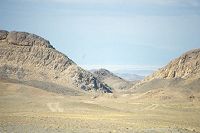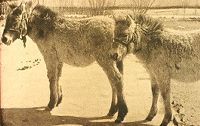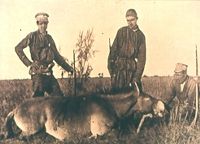The Przewalski horse, named after its rediscoverer, Colonel Nicolai Przewalski, is the last surviving truly wild horse. Together with other large grazers, wild horses were the natural inhabitants of the steppes that stretched from Europe deep into Asia. Prehistoric cave paintings bear witness to this.
The increase of the human population and its livestock and the cultivation of large tracts of land drove the wild horses into increasingly barren areas. Forced to leave the steppe, the last Przewalski horses ended up in the Dzungarian Gobi, a desert in southwest Mongolia, but even there they were threatened. Nomadic herdsmen and their livestock more and more occupied the already scarce watering places in the area. The number of Przewalski horses declined even further when border soldiers using modern weapons started hunting on a large scale. The last wild Przewalski horse, or “takhi”, as the Mongolians call it, was sighted in 1969 near a spring called Gun Tamga. The animal became extinct in the wild.
Around 1900, an animal trader and some, large landowners captured a large number of Przewalski foals. Only 53 of these survived the rough voyage from Mongolia to Europe. They were dispersed over a number of zoos and privately owned parks. All the captive Przewalski horses of today are descended from only 13 of these ancestors.
| The Takhiin Shar Nuruu mountains, in southwest Mongolia on the Chinese border, where the Przewalski horses last lived before they became extinct in the wild. | ||
|
Arrival of captured Przewalski foals in Europe. |
||
|
The Grum Grishmailo brothers, that first saw and captured a Przewalski horse. |
The present
During the last century, fortunately their numbers have increased to around 1800, all living in more than a hundred zoos or privately owned parks.
It has never been easy to breed these shy and truly wild animals in captivity. In many cases the enclosures in which they were kept were far too small, and only a minority of zoos could provide them with grass.
Before 1980 there was hardly any policy on the exchange of Przewalski horses between the different zoos and private parks. This resulted into high inbreeding, a proliferation of genetic diseases and anomalies. The animals’ average life span was considerably shortened, while infant mortality increased. Lesser Przewalski mares could give birth.
Something had to happen to save the sole remaining wild horses from its inevitable doom.



